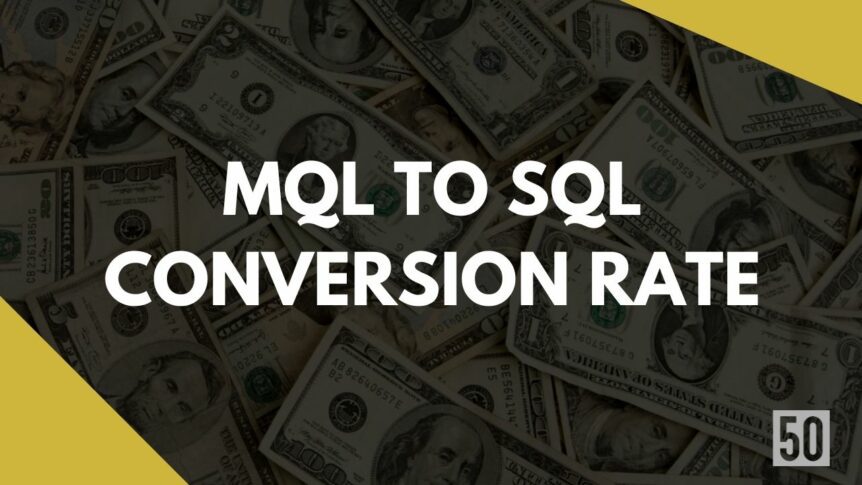Sales and marketing teams always look for ways to increase their conversion rates. After all, if you can convert more leads into customers, your business will be much more successful. In this blog post, we’ll look at the MQL to SQL conversion rate and provide some tips on improving it. Stay tuned!
What is MQL to SQL conversion rate?
The MQL (Marketing Qualified Lead) to SQL (Sales Qualified Lead) conversion rate is a measure of the effectiveness of the sales and marketing teams in identifying qualified prospects. The ratio of MQLs successfully converted to SQLs indicates how many leads the sales team can qualify and turn into customers. This rate is important in determining the performance of both marketing and sales activities. Understanding this metric can help businesses make adjustments to their strategies and processes in order to improve the MQL to SQL conversion rate.
Why Is It Important For Startups To Track MQL to SQL conversion rate Metric?
Tracking the MQL to SQL conversion rate is an important consideration for startups aiming to maximize their sales and marketing efforts. By understanding where potential leads are dropping off, businesses can quickly identify areas of weakness in their sales funnel and make changes accordingly.
Additionally, tracking this metric allows startups to spot trends and opportunities that could lead to increased conversions, such as reducing lead response time or implementing more effective messaging.
Finally, tracking the MQL to SQL conversion rate metric allows startups to accurately measure the success of their sales and marketing efforts and measure ROI on those initiatives. Understanding this metric could be key for startups looking to maximize their growth potential.
By keeping a close eye on the MQL to SQL conversion rate, startups can increase their profitability and success.
How do you calculate MQL to SQL conversion rate?
Here is the formula to calculate the MQL to SQL conversion rate:
SQLs generated / MQLs Generated * 100 = MQL to SQL Conversion Rate
Calculating the MQL to SQL Conversion Rate is easy. Follow the instructions:
Find the number of MQLs and SQLs generated
Analyze the MQL to SQL rate by determining the number of Marketing Qualified Leads (MQLs) and Sales Qualified Leads (SQLs) generated over a certain period. For instance, if 100 leads were generated in a month-long sales campaign and 40 converted into sales, the MQL to SQL rate would be 40/100 = 0.4 or 40%. This indicates that 4 out of 10 leads turn into sales on average.
Calculate the leads generated
Determine the amount of leads acquired during a specific period. For instance, if 100 potential customers were obtained for a one-month sales plan, the lead generation total would be 100.
What factors affect MQL to SQL conversion rate?
Here are some factors that affect MQL to SQL conversion rate:
Quality of Lead Sources
The quality of lead sources affects the MQL to SQL conversion rate. If the sources are unreliable and contain inaccurate data, the leads generated will be of poor quality and thus result in a lower MQL to SQL conversion rate.
Lead Nurturing:
Lead nurturing is one way to ensure that leads are qualified and ready to be contacted. By providing helpful information and engaging content, marketers can ensure that each lead is nurtured to the point of being ready to convert into an SQL.
Lead Intelligence:
Leveraging lead intelligence such as demographic data, past interactions, buying patterns and website behaviour helps marketers better understand a lead’s interests and needs. This helps marketers to segment leads into the most appropriate buckets and target them with relevant content that is more likely to result in an SQL.
Lead Scoring:
Lead scoring helps marketers prioritize leads based on their potential for conversion. By assigning a score to each lead, marketers can determine which leads should be pursued first and which require further nurturing.
Sales & Marketing Alignment:
When sales and marketing teams are in sync, leads can be handed off more quickly and convert more easily into SQLs. This alignment also helps marketers to track leads throughout the buyer’s journey in order to identify potential opportunities for improvement.
Database Cleanliness:
Inaccurate and outdated data in the database can significantly reduce the MQL to SQL conversion rate. It is important to regularly cleanse the database and remove any invalid or obsolete entries in order to ensure that all leads are tracked accurately.
These are just some of the factors that affect MQL to SQL conversion rate. By understanding these factors and taking the necessary steps to improve them, marketers can increase their MQL to SQL conversion rate and generate more qualified leads.
What are the effects of MQL on SQL conversion rate on a startup?
Here are the effects of MQL on SQL conversion rate on a startup:
1. Increased Lead Quality:
By navigating through a series of marketing and sales activities, MQLs help identify high-quality leads, who are more likely to convert into SQLs. This helps startups to focus their efforts and resources on the most promising leads and increase the likelihood of generating higher ROI (return on investment).
2. Higher Conversion Rate:
By using MQLs, startups can better understand their target customers’ interests and preferences. This leads to more effective targeting and higher conversion rate as leads can be tailored according to customer segment.
3. More Effective Use Of Resources:
With MQLs, startups can track the progress of each lead and focus on those leads which are more likely to convert. This helps startups to use their resources in the most efficient way and maximize the success of their campaigns.
4. Improved Lead Nurturing:
By using MQLs, startups can determine how long it takes for a lead to reach the SQL stage and measure the effectiveness of each step in the process. This helps startups to identify areas where their lead nurturing strategy can be improved, leading to higher conversion rates.
Overall, MQLs are an effective tool for startups aiming to maximize the success of their campaigns and increase SQL conversion rate. By using these insights, startups can create more targeted campaigns and use resources in the most efficient manner.
What is a good MQL to SQL conversion rate?
According to data from Salesforce, the average conversion rate of Marketing Qualified Leads (MQLs) to Sales Qualified Leads (SQLs) is 13%, and only 6% of those SQLs convert to actual deals. Employee and customer referrals are the most successful channels for converting leads to deals, followed by the company website and social media.
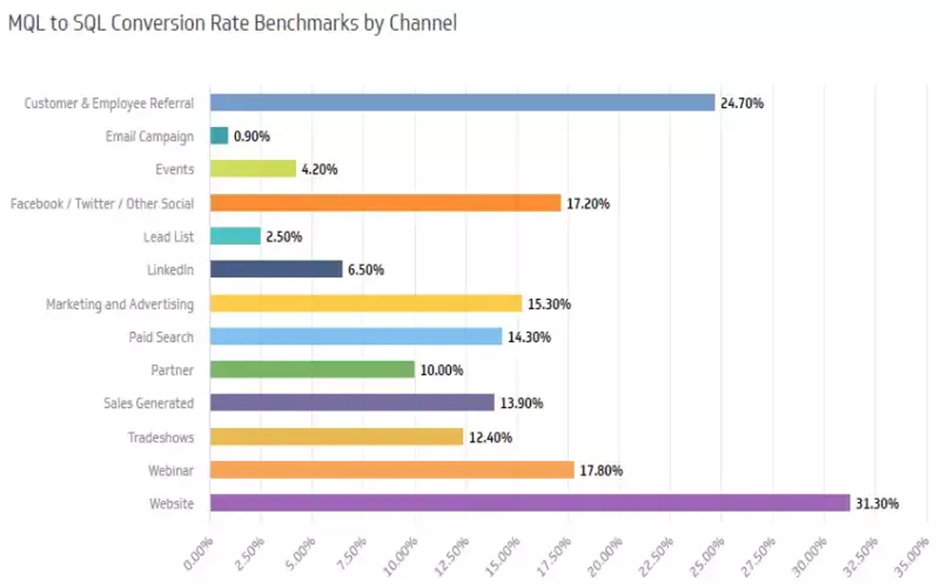
However, conversion rates will vary depending on the industry, product or service sold, and specific marketing tactics used. For example, if you’re selling a high-priced product or service, you’ll likely have a lower conversion rate than if you’re selling a low-priced product or service. Similarly, if you’re using relatively unsophisticated marketing tactics, you’ll also have a lower conversion rate.
What is a bad MQL to SQL conversion rate?
Depending on your team, digital marketing goals, lead lifecycle, and industry, a low conversion rate can be between 0% and 5%. Since the benchmark is about 13%, you can consider anything more than 13% a high conversion rate. Factors that contribute to a low MQL to SQL conversion rate include unrealistic expectations set for leads, poor quality of leads, lack of clarity around what an MQL is, and not having dedicated sales development representatives (SDRs).
What are examples of MQL to SQL conversion rate?
ChartExpo has a collection of amazing data visualizations that you can use to present your information in an insightful manner. For example, check out the Group Column Chart below. This type of chart allows you to easily compare data side by side, providing a clear picture of how your information is related.
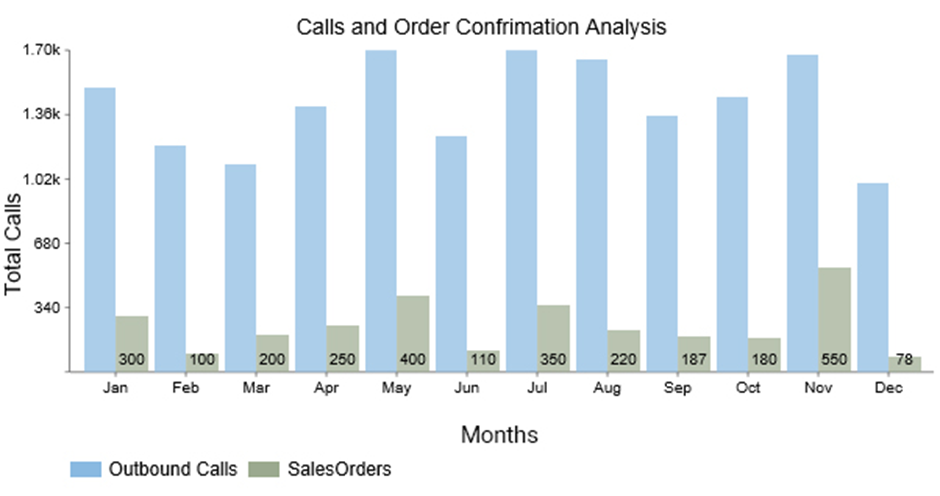
Why not try using a visualization that shows both bars and lines to track the conversion rate from MQLs to SQLs? Doing this could give you a better look at the data and help gain further insights.
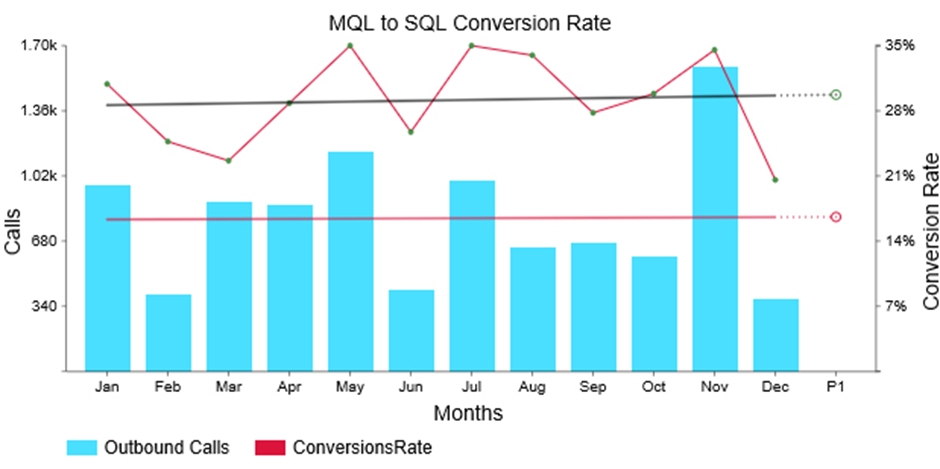
The same data can be shown with another visualization so that you can compare it side by side.
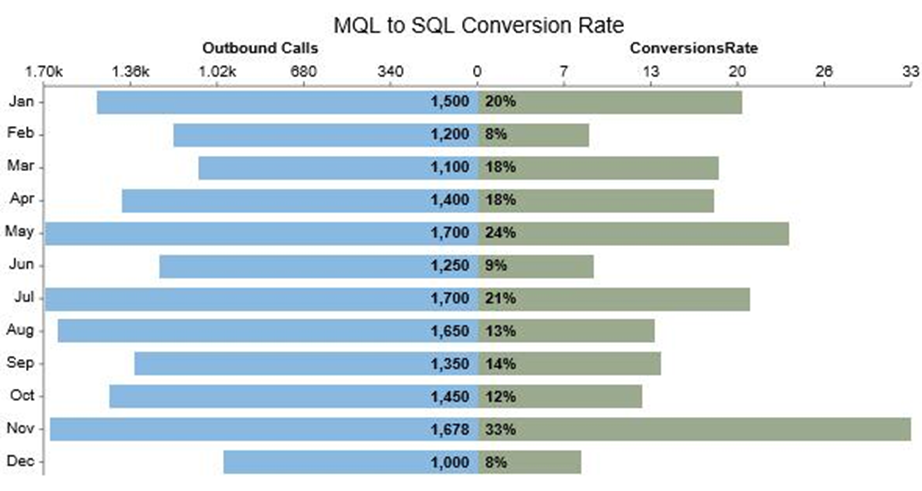
What are tips to increase MQL to SQL Conversion Rate?
Here are some strategies to increase MQL to SQL conversion rate:
Understand your target buyers:
Identify who your ideal customer is and create effective messaging to attract them. Make sure you understand your customers’ needs so that you can tailor content and campaigns to them.
Improve lead scoring:
Utilize lead scoring technology or methods to ensure that when an MQL becomes a SQL it is a qualified lead.
Create compelling content:
Create high-quality, informative content that resonates with your target buyers. This will help to encourage MQLs to convert into SQLs by providing them with the information they need to make an informed decision.
Increase the visibility of call-to-actions:
Ensure that your call-to-action buttons are visible and prominent on all of your webpages.
Regularly review conversion rates:
Monitor the MQL to SQL conversion rate and adjust strategies where necessary to ensure that you achieve the desired results.
Utilize marketing automation:
Automate processes such as lead nurturing, lead scoring, and email campaigns. This will help to ensure that leads are properly nurtured and qualified before being converted into SQLs.
By following these strategies you can increase your MQL to SQL conversion rate and generate more sales-ready leads for your business.
Tips for tracking MQL to SQL Conversion Rate
There are a few simple tips that businesses can follow to track their MQL to SQL Conversion Rate.
First, it is important to clearly understand what constitutes an MQL. This can vary from business to business, but it generally refers to a leader who has shown interest in your product or service. Once you have defined an MQL, you need to track how many leads are generated each month.
This can be done through website analytics or by manually tracking leads. Once you know how many leads are being generated, you need to track how many are converted into customers. The best way to do this is by setting up goal tracking in Google Analytics. By tracking this metric, businesses can ensure that they are generating quality leads and converting them into customers.
Conclusion
If you can increase your MQL to SQL conversion rate, you’ll be able to get more leads that turn into customers. Following the steps in this guide, you can Optimize Your Campaigns to Improve your MQL to SQL Conversion Rate.

